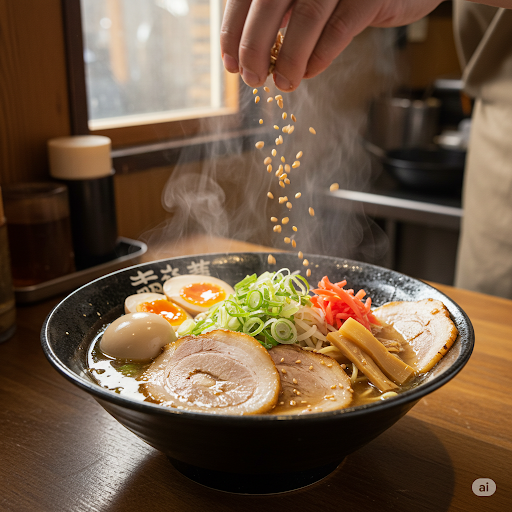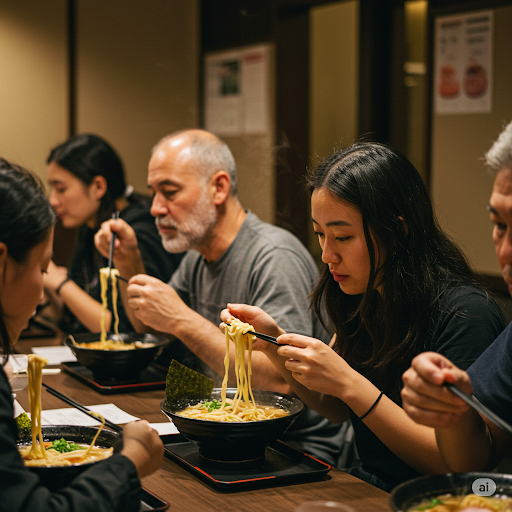Ramen is a noodle soup unique to Japanese cuisine, derived in the early twentieth century from Chinese-origin noodle dishes. Today, it has become a widely consumed type of food both in Japan and around the world. At its core, it consists of noodles made from wheat flour, water, salt, and a mixture known as kansui (alkaline water), served in a broth typically based on meat or fish. Ramen is notable for its regional and local variations, and it reflects significant cultural diversity in terms of ingredients and preparation methods.

Ramen (Generated by Artificial Intelligence)
Historical Origins and Development
Transition from China to Japan
The origins of ramen lie in the Chinese dish known as lamian, which features hand-pulled noodles. Ramen began to gain recognition in Japan during the early 20th century, particularly in port cities with large Chinese populations such as Yokohama, where Chinese restaurants introduced the dish. However, ramen’s full integration into Japanese cuisine and its development into a distinct culinary form occurred in the first half of the 20th century. The restaurant Rairaiken, which opened in Tokyo in 1910, is considered the first establishment where Chinese-style noodle soup was adapted and served according to Japanese tastes by Japanese chefs.
Post-War Period and Modernization
Following World War II, the food shortages and economic difficulties in Japan led to a rise in ramen’s popularity as an inexpensive and filling meal. Wheat flour aid provided during the American occupation facilitated the production of noodles, accelerating the spread of ramen. In 1958, Japanese entrepreneur Momofuku Ando developed and launched the first packaged instant ramen, transforming it into a mass-consumed product. From the 1980s onward, ramen was rebranded as a symbol of Japanese culture, promoted through ramen-themed restaurants, festivals, and museums both domestically and internationally.
Regional Variations
The preparation of ramen exhibits regional variations across Japan. In Hokkaido, miso ramen is known for its rich broth made from fermented soybean paste. In Kyushu, particularly in Hakata, tonkotsu ramen is characterized by a thick, milky broth made from pork bone marrow. In Tokyo, shoyu ramen, which uses a soy sauce-based broth, is the most common. These variations reflect the influence of local ingredients and regional taste preferences on ramen.
Ingredients and Preparation Methods
Noodle Structure
Noodles are the foundational component of ramen and are more than just a mix of flour and water. A unique ingredient called kansui—an alkaline solution containing sodium carbonate and potassium carbonate—gives ramen noodles their characteristic elasticity and slightly yellow hue. This feature distinguishes ramen noodles from other types of Asian noodles. The thickness, shape, and length of noodles vary depending on the region. Some versions use thin and straight noodles, while others prefer thick and wavy ones. The consistency of the noodles must be well-matched with the broth’s intensity and texture.
Broth Bases
Ramen broths are typically made using one of four main bases: shoyu (soy sauce), miso (fermented soybean paste), shio (salt), and tonkotsu (pork bone marrow). These bases are enriched with various combinations of meat stock, fish stock, or vegetable broth. Shoyu ramen is one of the most traditional and widely consumed varieties, known for its clear and savory soup. Miso ramen offers a thicker and darker broth, often enjoyed in colder months. Shio ramen features a light, salty taste and is frequently served with seafood. Tonkotsu ramen, on the other hand, is made by simmering pork bones for extended periods, producing a rich and fatty soup.
Toppings and Garnishes
Ramen is complemented with a variety of toppings in addition to its core ingredients. Common additions include soft-boiled seasoned egg (ajitsuke tamago), dried seaweed (nori), bamboo shoots (menma), chopped green onions, marinated pork slices (char siu), and fish cakes (narutomaki). The choice of toppings varies depending on the regional type of ramen and the style of the restaurant.

Ramen Ingredients (Generated by Artificial Intelligence)
Social and Cultural Significance
Ramen Restaurants and Consumption Culture
Ramen holds a place in Japan not only as a dish but also as an integral part of daily life. Across the country, numerous ramen restaurants operate, often characterized by fast service and high customer turnover. These establishments usually offer limited menus and specialize in specific types of ramen. Consumption is typically rapid and the dish is served at high temperatures, aligning with the fast-paced lifestyle of Japanese society. While some restaurants adhere strictly to traditional recipes, others innovate by creating original variations.
Popular Culture and Global Spread
Ramen has become a modern cultural symbol of Japan, appearing in cinema, television, and literature. Internationally, ramen is recognized as a subcategory of Japanese cuisine and is gaining popularity worldwide due to the increasing number of Japanese restaurants abroad. Packaged instant ramen, in particular, has become a widely favored food product because of its low cost and convenience.
Museums and Festivals
Various museums and festivals in Japan celebrate ramen’s cultural value. One of the most notable examples is the Yokohama Ramen Museum. Such institutions present the history, varieties, and preparation processes of ramen while offering visitors the opportunity to taste different types. Ramen festivals serve as platforms for promoting local producers and encouraging gastronomic tourism. These events highlight that ramen is not merely a food item but also a cultural identity element.

People Eating Ramen in Restaurants (Generated by Artificial Intelligence)


